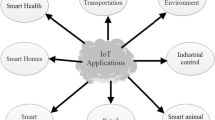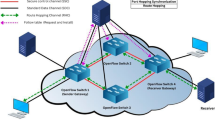Abstract
In wireless sensor deployments, network layer multicast can be used to improve the bandwidth and energy efficiency for a variety of applications, such as service discovery or network management. However, despite efforts to adopt IPv6 in networks of constrained devices, multicast has been somewhat overlooked. The Multicast Forwarding Using Trickle (Trickle Multicast) internet draft is one of the most noteworthy efforts. The specification of the IPv6 routing protocol for low power and lossy networks (RPL) also attempts to address the area but leaves many questions unanswered. In this paper we highlight our concerns about both these approaches. Subsequently, we present our alternative mechanism, called stateless multicast RPL forwarding algorithm (SMRF), which addresses the aforementioned drawbacks. Having extended the TCP/IP engine of the Contiki embedded operating system to support both trickle multicast (TM) and SMRF, we present an in-depth comparison, backed by simulated evaluation as well as by experiments conducted on a multi-hop hardware testbed. Results demonstrate that SMRF achieves significant delay and energy efficiency improvements at the cost of a small increase in packet loss. The outcome of our hardware experiments show that simulation results were realistic. Lastly, we evaluate both algorithms in terms of code size and memory requirements, highlighting SMRF’s low implementation complexity. Both implementations have been made available to the community for adoption.



















Similar content being viewed by others
Notes
In the version of the Contiki OS used for this research, each entry in the IPv6 routing table occupies approximately 48 bytes of RAM, the exact number depending on the hardware platform and toolchain.
References
Hui, J. W., & Culler, D. E. (2008). IP is dead, long live IP for wireless sensor networks. In Proceedings of the 6th ACM conference on Embedded network sensor systems (SenSys’08) (pp. 15–28).
Montenegro, G., Kushalnagar, N., Hui, J. W., & Culler, D. E. (2007). Transmission of IPv6 packets over IEEE 802.15.4 networks. RFC 4944.
Hui (editor), J., & Thubert, P. (2011). Compression format for IPv6 Datagrams over IEEE 802.15.4-Based Networks. RFC 6282.
Winter (editor), T., Thubert (editor), P., Brandt, A., Hui, J., Kelsey, R., Levis, P., et al. (2012). RPL: IPv6 Routing Protocol for Low power and Lossy Networks. RFC 6550.
Butt, T. A., Phillips, I., Guan, L., & Oikonomou, G. (2012). TRENDY: An adaptive and context-aware service discovery protocol for 6LoWPANs. In Proceedings of the third international workshop on the web of things (WoT 2012). Newcastle, UK.
Klauck, R., & Kirsche, M. (2012). Bonjour contiki: A case study of a DNS-based discovery service for the internet of things. In Proceedings of the 11th international IEEE conference on ad-hoc networks and wireless (ADHOC-NOW 2012) Lecture Notes in Computer Science (LNCS) (Vol. 7363, pp. 316–329). Berlin: Springer.
Cheshire, S., & Krochmal, M. (2013). Multicast DNS. RFC 6762.
Lynn, K., & Sturek, D. (2012). Extended multicast dns. Internet Draft (version 01). (draft-lynn-homenet-site-mdns-01).
Cheshire, S., & Krochmal, M. (2013). DNS-based service discovery. RFC 6763.
Klauck, R., & Kirsche, M. (2013). Enhanced DNS message compression—optimizing mDNS/DNS-SD for the use in 6LoWPANs. In Proceedings of the 9th international workshop on sensor networks and systems for pervasive computing (PerSeNS 2013).
Shelby, Z., Hartke, K., & Bormann, C. (2013). Constrained application protocol (CoAP). Internet Draft. (draft-ietf-core-coap-15).
Sanchez, J. A., Ruiz, P. M., Liu, J., & Stojmenovic, I. (2007). Bandwidth-efficient geographic multicast routing protocol for wireless sensor networks. IEEE Sensors Journal, 7(5), 627–636.
Sanchez, J. A., Marin-Perez, R., & Ruiz, P. M. (2012). Beacon-less geographic multicast routing in a real-world wireless sensor network testbed. Wireless Networks, 18(5), 565–578.
Carzaniga, A., Khazaei, K., & Kuhn, F. (2012). Oblivious low-congestion multicast routing in wireless networks. In Proceedings of the thirteenth international symposium on mobile ad hoc networking and computing (MobiHoc 2012).
Feng, C. H., Zhang, Y., Demirkol, I., & Heinzelman, W. B. (2012). Stateless multicast protocol for ad hoc networks. IEEE Transactions on Mobile Computing, 11(2), 240–253.
Koutsonikolas, D., Das, S. M., Hu, Y. C., & Stojmenovic, I. (2010). Hierarchical geographic multicast routing for wireless sensor networks. Wireless Networks, 16(2), 449–466.
Song, S., Choi, B. Y., Kim, D. (2010). MR. BIN: Multicast routing with branch information nodes for wireless sensor networks. In Proceedings of the 19th international conference on computer communications and networks (ICCCN 2010) (pp. 1–6).
Hui, J., & Kelsey, R. (2012). Multicast forwarding using trickle. Internet Draft (version 01). (draft-ietf-roll-trickle-mcast-01).
Oikonomou, G., & Phillips, I. (2011). Experiences from porting the contiki operating system to a popular hardware platform. In Proceedings of the 2011 international conference on distributed computing in sensor systems and workshops (DCOSS). Spain: Barcelona.
Oikonomou, G., & Phillips, I. (2012). Stateless multicast forwarding with RPL in 6LoWPAN sensor networks. In Proceedings of the 2012 IEEE international conference on pervasive computing and communications workshops (PERCOM Workshops). Switzerland: Lugano.
Das, S. M., Pucha, H., & Hu, Y. C. (2008). Distributed hashing for scalable multicast in wireless ad hoc networks. IEEE Transactions on Parallel and Distributed Systems, 19(3), 347–362.
Song, S., Kim, D., & Choi, B. Y. (2009). Agsmr: Adaptive geo-source multicast routing for wireless sensor networks. In Proceedings of the wireless algorithms, systems, and applications, Lecture notes in computer science (Vol. 5682, pp. 200–209). Springer:Berlin/Heidelberg.
Okura, A., Ihara, T., & Miura, A. (2005). Bam: branch aggregation multicast for wireless sensor networks. In: IEEE international conference on mobile ad hoc and sensor systems conference (pp. 354–363).
Flury, R., & Wattenhofer, R. (2006). MLS: An efficient location service for mobile ad hoc networks. In Proceedings of the 7th ACM international symposium on mobile ad hoc networking and computing (MOBIHOC) (pp. 226–237).
Li, J., Jannotti, J., De Couto, D. S. J., Karger, D. R., & Morris, R. (2000). A scalable location service for geographic ad hoc routing. In Proceedings of the 6th annual international conference on mobile computing and networking, MobiCom’00 (pp. 120–130).
Sá, Silva J., Camilo, T., Pinto, P., Ruivo, R., Rodrigues, A., Gaudêncio, F., et al. (2008). Multicast and ip multicast support in wireless sensor networks. Journal of Networks, 3(3), 19–26.
Royer, E. M., & Perkins, C. E. (1999). Multicast operation of the ad-hoc on-demand distance vector routing protocol. In Proceedings of the 5th annual ACM/IEEE international conference on Mobile computing and networking (MobiCom’99) (pp. 207–218).
Bhattacharyya, S. (Ed.) (2003). An overview of source-specific multicast (SSM). RFC 3569.
Clausen, T., & Herberg, U. (2010). Comparative study of RPL-enabled optimized broadcast in wireless sensor networks. In Proceedings of the sixth international conference on intelligent sensors, sensor networks and information processing (ISSNIP 2010). Brisbane, Australia: IEEE.
Levis, P., Patel, N., Culler, D., & Shenker, S. (2004). Trickle: A self-regulating algorithm for code propagation and maintenance in wireless sensor networks. In Proceedings of the first USENIX/ACM symposium on networked systems design and implementation (NSDI) (pp. 15–28).
Levis, P., Clausen, T.H., Hui, J., Gnawali, O., & Ko, J. (2011). The trickle algorithm. RFC 6206.
Levis, P., Brewer, E., Culler, D., Gay, D., Madden, S., Patel, N., et al. (2008). The emergence of a networking primitive in wireless sensor networks. Communications of the ACM, 51(7), 99–106.
Hui, J., & Culler, D. (2004). The dynamic behavior of a data dissemination protocol for network programming at scale. In Proceedings of the 2nd international conference on Embedded networked sensor systems (SenSys) (pp. 81–94).
Lin, K., & Levis, P. (2008). Data discovery and dissemination with DIP. In Proceedings of 7th international conference on information processing in sensor networks, IPSN’08 (pp. 433–444). Washington, DC, USA: IEEE.
Hui, J., & Vasseur, J. P. (2012). The routing protocol for low-power and lossy networks (RPL) option for carrying RPL information in data-plane datagrams. RFC 6553.
Dunkels, A. (2011). The ContikiMAC radio duty cycling protocol. Technical Report T2011:13, Swedish Institute of Computer Science.
Dunkels, A., Mottola, L., Tsiftes, N., Österlind, F., Eriksson, J., & Finne, N. (2011). The announcement layer: Beacon coordination for the sensornet stack. In Proceedings of the European conference on wireless sensor networks (EWSN).
Österlind, F., & Dunkels, A. (2008). Approaching the maximum 802.15.4 multi-hop throughput. In Proceedings of the fifth ACM workshop on embedded networked sensors (HotEmNets 2008).
Duquennoy, S., Österlind, F., & Dunkels, A. (2011). Lossy links, low power, high throughput. In Proceedings of the 9th ACM conference on embedded networked sensor systems (SenSys 2011).
Michopoulos, V., Guan, L., Oikonomou, G., & Phillips, I. (2012). DCCC6: Duty cycle-aware congestion control for 6LoWPAN networks. In Proceedings of the 2012 IEEE international conference on pervasive computing and communications workshops (PERCOM Workshops). Switzerland: Lugano.
Dunkels, A., Österlind, F., Tsiftes, N., & He, Z. (2007). Demo abstract: Software-based sensor node energy estimation. In Proceedings of the fifth ACM conference on networked embedded sensor systems (SenSys 2007). Sydney, Australia: ACM.
Dunkels, A., Österlind, F., Tsiftes, N., & He, Z. (2007). Software-based on-line energy estimation for sensor nodes. In Proceedings of the fourth workshop on embedded networked sensors (Emnets IV). Cork, Ireland: ACM.
Tmote sky: Ultra low power IEEE 802.15.4 compliant wireless sensor module. Moteiv Corporation (2006). Tmote Sky Datasheet Revision 1.0.2.
A True System on Chip solution for 2.4 GHz IEEE 802.15.4/Zigbee®. (2007). CC2430 Data Sheet (rev. 2.1).
Author information
Authors and Affiliations
Corresponding author
Rights and permissions
About this article
Cite this article
Oikonomou, G., Phillips, I. & Tryfonas, T. IPv6 Multicast Forwarding in RPL-Based Wireless Sensor Networks. Wireless Pers Commun 73, 1089–1116 (2013). https://doi.org/10.1007/s11277-013-1250-5
Published:
Issue Date:
DOI: https://doi.org/10.1007/s11277-013-1250-5




